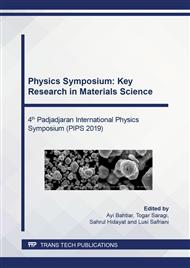[1]
X. Zheng, Y. Li, L., Zhang, L. Shen, Y. Xiao, Y. Zhang, C. Au, L. Jiang, Insight into the effect of morphology on catalytic performance of porous CeO2 nanocrystal for H2S selective oxidation, Appl. Catal. B-Environ. 252 (2019) 98-110.
DOI: 10.1016/j.apcatb.2019.04.014
Google Scholar
[2]
K. Anupriya, E. Vivek, B. Subramanian, Facile synthesis of ceria nanoparticles by precipitation route for UV blockers, J. Alloys Compd. 590 (2014) 406-410.
DOI: 10.1016/j.jallcom.2013.12.121
Google Scholar
[3]
D. Gil, J. Rodriguez, B. Ward, A. Vertegel, V. Ivanov, V. Reukov, Antioxidant activity of SOD and Catalase Conjugated with Nanocrystalline Ceria, Bioeng. 4 (2017) 1-9.
DOI: 10.3390/bioengineering4010018
Google Scholar
[4]
I. Nurhasanah, W. Safitri, T. Windarti, A.Subagio, The calcination temperature effect on the antioxidant and radioprotection propertis of CeO2 nanoparticles, Reaktor. 18 (2018) 22-26.
DOI: 10.14710/reaktor.18.1.22-26
Google Scholar
[5]
H. Wang, Y. Zhong, H. Yu, P. Aprea, S. Hao, High efficiency adsorption for acid dyes over CeO2 . xH2O synthesized by a facile method, J. Alloys Compd. 776 (2019) 96-104.
DOI: 10.1016/j.jallcom.2018.10.228
Google Scholar
[6]
J. Sun, C. Wang, L. Zeng, P. Xu, X.Yang, J. Chen, X. Xing, Q. Jin, R. Yu, Controllable assembly of CeO2 micro/nanospheres with adjustable size and their application in Cr(IV) adsorption, Mater. Res. Bull. 75 (2016) 110-114.
DOI: 10.1016/j.materresbull.2015.11.035
Google Scholar
[7]
P. Ji, J. Zhang, F. Chen, M. Anpo, Study of adsorption and degradation of acid orange 7 on the surface of CeO2 under visible light irradiation, Appl. Catal. B 85(2009) 148-154.
DOI: 10.1016/j.apcatb.2008.07.004
Google Scholar
[8]
S. Recillas, J. Colon, E. Casals, E. Gonzalez, V. Puntes, A. Sanchez, X. Font, Chromium VI adsorption on cerium oxide nanoparticles and morphology changes during process, J. Hazard. Mater. 184 (2010) 425-431.
DOI: 10.1016/j.jhazmat.2010.08.052
Google Scholar
[9]
Q. Feng, Z. Zhang, Y. Ma, X. He, Y. Zhao, Z. Chai, Adsorption and desorption characteristics of arsenic onto ceria nanoparticles, Nanoscale Res. Lett. 7/84 (2012) 1-8.
DOI: 10.1186/1556-276x-7-84
Google Scholar
[10]
M.A.M. Khan, W. Khan, M. Ahamed, A.N. Alhazaa, Microstructural properties and enhanced photocatalytic performance of Zn doped CeO2 nanocrystals, Sci. Rep. 7 (2017) 12560.
DOI: 10.1038/s41598-017-11074-7
Google Scholar
[11]
M. Brigante, P.C. Schulz, Adsorption of the antibiotic minocycline on cerium (IV) oxide: Effect of pH, ionic strength and temperature, Microporous Mesoporous Mater. 156 (2012) 138-144.
DOI: 10.1016/j.micromeso.2012.02.033
Google Scholar
[12]
H.R. Pouretedal, N. Sadegh, Effective removal of amoxicillin, cephalexin, tetracycline and penicilin G from aqueous solution using activated carbon nanoparticles prepared from vine wood, J. Water Process Eng. 1 (2014) 64-73.
DOI: 10.1016/j.jwpe.2014.03.006
Google Scholar
[13]
M.A. Chayid, M.J. Ahmed, Amoxicillin adsorption on microwave prepared activated carbon from Arundo donax Linn: Isotherms, kinetics, and thermodynamics studies, J. Environ. Chem. Eng. 3 (2015) 1592-1601.
DOI: 10.1016/j.jece.2015.05.021
Google Scholar
[14]
O. Pezoti, A.L. Cazetta, K.C. Bedin, L.S. Souza, A.C. Martins, T.L. Silva, O.O. Santos Junior, J.V. Visentainer, V.C. Almeida, NaOH-activated carbon of high surface area produced from guava seeds as a high-efficiency adsorbent for amoxicillin removal: Kinetic, isotherm and thermodynamic studies, Chem. Eng. J. 288 (2016) 778-788.
DOI: 10.1016/j.cej.2015.12.042
Google Scholar
[15]
L. Sellaoui, E.C. Lima, G.L Dotto, A.B. Lamine, Adsorption of amoxicillin and paracetamol on modified activated carbons: Equilibrium and positional entropy studies, J. Mol. Liq. 234(2017) 375-381.
DOI: 10.1016/j.molliq.2017.03.111
Google Scholar
[16]
M.B. Ahmed, J.L. Zhou, H.H. Ngo, W. Gao, Adsorptive removal of antibiotics from water and wastewater: Progress and challenges, Sci. Total. Environ. 532 (2015) 112-126.
DOI: 10.1016/j.scitotenv.2015.05.130
Google Scholar
[17]
O. Kerkez-Kuyumcu, S.S. Bayazit, M.A. Salam, Antibiotic amoxicillin removal from aqueous solution using magnetically modified graphene nanoplatelets, J. Ind. Eng. Chem. 36 (2016) 198-205.
DOI: 10.1016/j.jiec.2016.01.040
Google Scholar
[18]
S. Aydin, M.E. Aydin, F. Beduk, A. Ulvi, Removal of antibiotics from aqueous solution by using magnetic Fe3O4/red mud-nanoparticles, Sci. Total Environ. 670 (2019) 539-546.
DOI: 10.1016/j.scitotenv.2019.03.205
Google Scholar


